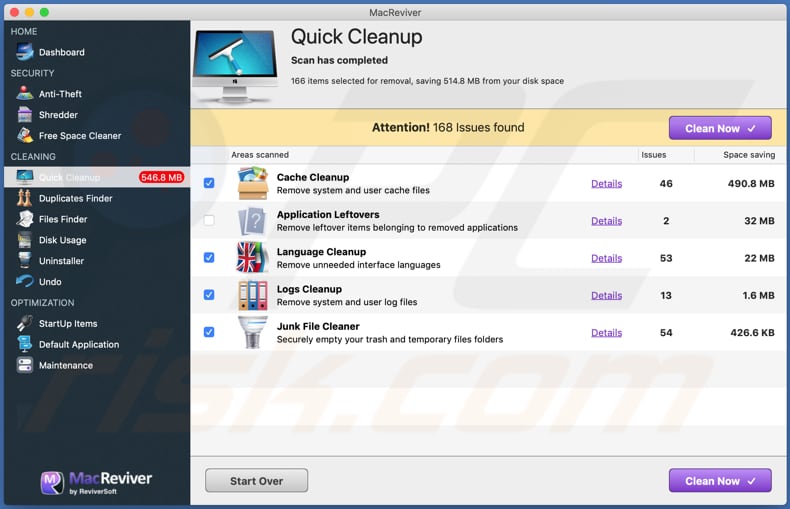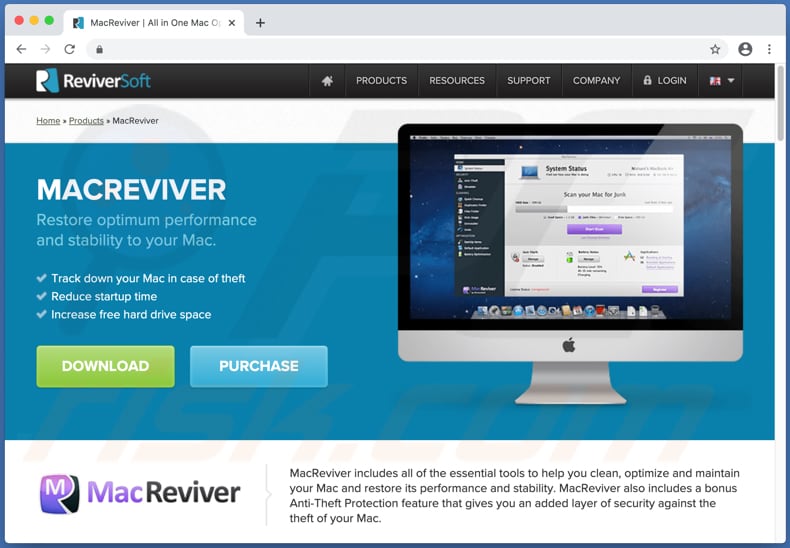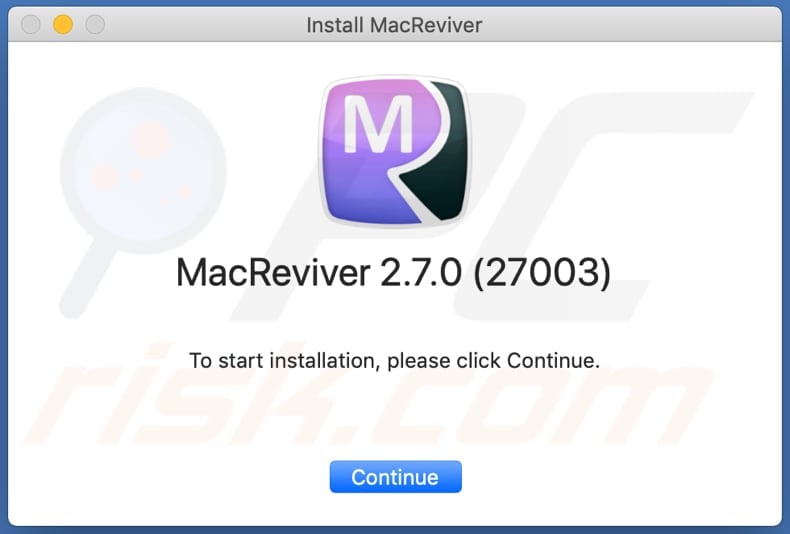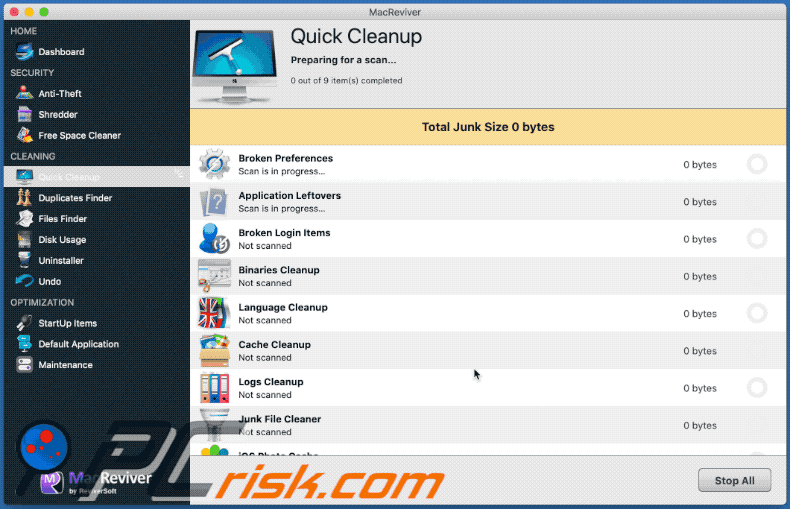How to uninstall MacRevicer from Mac computers
Mac VirusAlso Known As: MacRevicer potentially unwanted application
Get free scan and check if your device is infected.
Remove it nowTo use full-featured product, you have to purchase a license for Combo Cleaner. Seven days free trial available. Combo Cleaner is owned and operated by RCS LT, the parent company of PCRisk.com.
What is MacReviver?
MacReviver is advertised as software that helps Mac users to improve system performance and stability, however, various virus detection engines recognize its installer as that of a potentially unwanted application (PUA). Typically, apps of this type are distributed through the set-ups of other (usually free) programs and/or various deceptive websites.
Therefore, people often download and install PUAs unintentionally, or they are deceived into it. In any case, apps categorized as PUAs should never be trusted.

MacReviver allows users to scan systems for junk files, unwanted applications, remaining items owned by removed apps, redundant interface languages, cache, log files and other items, and to remove them. This software essentially cleans, optimizes and maintains Mac computers, and also restores performance and stability.
Note that this software is not free. To use its features (remove 'detected issues') users must purchase it. PUAs tend to provide fake results and attempt to trick people into believing that there are many existing issues that, if fixed, would improve computer performance, stability, and so on.
It is not known whether MacReviver is one of these applications, however, this is a strong possibility. PUAs are often installed through the set-ups of other programs - the set-ups are used to distribute multiple PUAs and various browser hijackers, adware, and other potentially unwanted apps are also installed.
Browser hijacking apps promote fake search engines by changing certain browser settings and gathering various browsing-related information. Sometimes apps of this type target private, sensitive details as well. Adware feeds users with coupons, pop-ups, surveys, banners and other forms of ads.
In most cases, these redirect people who click them to untrusted, potentially malicious pages, or they execute scripts designed to download and install PUAs. It is possible that the ads might cause installation of malicious programs.
If apps of this type are installed on the browser and/or operating system, remove them immediately. Do not download or install any apps categorized as PUAs.
| Name | MacRevicer potentially unwanted application |
| Threat Type | PUP (potentially unwanted program), PUA (potentially unwanted application), Mac malware, Mac virus. |
| Supposed Functionality | Optimizes and cleans Mac computers. |
| Detection Names | Arcabit (Application.MAC.MacReviver.A), BitDefender (Application.MAC.MacReviver.A), ESET-NOD32 (OSX/MacReviver.A Potentially Unwanted), Microsoft (PUA:Win32/Presenoker), Full List Of Detections (VirusTotal) |
| Symptoms | A program that you do not recall installing suddenly appeared on your computer. A new application is performing computer scans and displays warning messages about 'found issues'. Asks for payment to eliminate the supposedly found errors. |
| Distribution Methods | Deceptive pop-up ads, free software installers (bundling), fake Flash Player installers. |
| Damage | Monetary loss (unnecessary purchase of fake software), unwanted warning pop-ups, slow computer performance. |
| Malware Removal (Windows) |
To eliminate possible malware infections, scan your computer with legitimate antivirus software. Our security researchers recommend using Combo Cleaner. Download Combo CleanerTo use full-featured product, you have to purchase a license for Combo Cleaner. 7 days free trial available. Combo Cleaner is owned and operated by RCS LT, the parent company of PCRisk.com. |
More examples of apps that are classified as PUAs include MacRepair, iWebPlayer and Total Mac Care. Most PUAs are advertised through deceptive websites (such as "Your Apple iPhone is severely damaged by (6) viruses!") or through the download/installation set-ups of other (mostly free) software.
They are commonly advertised as legitimate, useful applications, however, many they are useless and deliver no real value.
How did potentially unwanted applications install on my computer?
People usually download and install unwanted apps when they are included into the download/installation set-ups of other software. This distribution method is known as "bundling". Typically, developers use it to trick people into downloading or installing PUAs together with regular software.
Generally, offers to download or install PUAs can be found in settings such as "Custom" and " Advanced", however, many people fail to check and change them, thereby allowing bundled PUAs to be downloaded and installed with regular software. In some cases, unintentional downloads and installations are caused by clicking deceptive ads.
If clicked, some ads execute scripts designed to download and install potentially unwanted, malicious apps.
How to avoid installation of potentially unwanted applications
Software and files should be downloaded only from official, trustworthy websites and via direct download links. Other sources and tools such as third party downloaders, installers, Peer-to-Peer networks (for example, torrent clients, eMule), unofficial pages, etc., should not be trusted.
Unwanted downloads and installations can be prevented by checking settings such as "Custom", "Advanced" of the download/installation setup and declining offers to download or install additionally-included software (PUAs).
Do not click intrusive advertisements, especially if they are shown on dubious websites - they often redirect to potentially malicious websites or cause download/installation of unwanted applications. Ads of this kind might also appear on legitimate sites.
Remove any unwanted, suspicious extensions, plug-ins, and add-ons already installed on the browser, and programs of this type installed on the computer. If your computer is already infected with PUAs, we recommend running a scan with Combo Cleaner Antivirus for Windows to automatically eliminate them.
MacReviver download website:

MacReviver installer:

Appearance of MacReviver application (GIF):

Instant automatic malware removal:
Manual threat removal might be a lengthy and complicated process that requires advanced IT skills. Combo Cleaner is a professional automatic malware removal tool that is recommended to get rid of malware. Download it by clicking the button below:
DOWNLOAD Combo CleanerBy downloading any software listed on this website you agree to our Privacy Policy and Terms of Use. To use full-featured product, you have to purchase a license for Combo Cleaner. 7 days free trial available. Combo Cleaner is owned and operated by RCS LT, the parent company of PCRisk.com.
Quick menu:
- What is MacReviver?
- STEP 1. Remove PUA related files and folders from OSX.
- STEP 2. Remove rogue extensions from Safari.
- STEP 3. Remove rogue add-ons from Google Chrome.
- STEP 4. Remove potentially unwanted plug-ins from Mozilla Firefox.
Video showing how to remove adware and browser hijackers from a Mac computer:
Potentially unwanted applications removal:
Remove potentially unwanted applications from your "Applications" folder:

Click the Finder icon. In the Finder window, select "Applications". In the applications folder, look for "MPlayerX", "NicePlayer", or other suspicious applications and drag them to the Trash. After removing the potentially unwanted application(s) that cause online ads, scan your Mac for any remaining unwanted components.
DOWNLOAD remover for malware infections
Combo Cleaner checks if your computer is infected with malware. To use full-featured product, you have to purchase a license for Combo Cleaner. 7 days free trial available. Combo Cleaner is owned and operated by RCS LT, the parent company of PCRisk.com.
Remove adware-related files and folders

Click the Finder icon, from the menu bar. Choose Go, and click Go to Folder...
 Check for adware generated files in the /Library/LaunchAgents/ folder:
Check for adware generated files in the /Library/LaunchAgents/ folder:

In the Go to Folder... bar, type: /Library/LaunchAgents/

In the "LaunchAgents" folder, look for any recently-added suspicious files and move them to the Trash. Examples of files generated by adware - "installmac.AppRemoval.plist", "myppes.download.plist", "mykotlerino.ltvbit.plist", "kuklorest.update.plist", etc. Adware commonly installs several files with the exact same string.
 Check for adware generated files in the ~/Library/Application Support/ folder:
Check for adware generated files in the ~/Library/Application Support/ folder:

In the Go to Folder... bar, type: ~/Library/Application Support/

In the "Application Support" folder, look for any recently-added suspicious folders. For example, "MplayerX" or "NicePlayer", and move these folders to the Trash.
 Check for adware generated files in the ~/Library/LaunchAgents/ folder:
Check for adware generated files in the ~/Library/LaunchAgents/ folder:

In the Go to Folder... bar, type: ~/Library/LaunchAgents/

In the "LaunchAgents" folder, look for any recently-added suspicious files and move them to the Trash. Examples of files generated by adware - "installmac.AppRemoval.plist", "myppes.download.plist", "mykotlerino.ltvbit.plist", "kuklorest.update.plist", etc. Adware commonly installs several files with the exact same string.
 Check for adware generated files in the /Library/LaunchDaemons/ folder:
Check for adware generated files in the /Library/LaunchDaemons/ folder:

In the "Go to Folder..." bar, type: /Library/LaunchDaemons/

In the "LaunchDaemons" folder, look for recently-added suspicious files. For example "com.aoudad.net-preferences.plist", "com.myppes.net-preferences.plist", "com.kuklorest.net-preferences.plist", "com.avickUpd.plist", etc., and move them to the Trash.
 Scan your Mac with Combo Cleaner:
Scan your Mac with Combo Cleaner:
If you have followed all the steps correctly, your Mac should be clean of infections. To ensure your system is not infected, run a scan with Combo Cleaner Antivirus. Download it HERE. After downloading the file, double click combocleaner.dmg installer. In the opened window, drag and drop the Combo Cleaner icon on top of the Applications icon. Now open your launchpad and click on the Combo Cleaner icon. Wait until Combo Cleaner updates its virus definition database and click the "Start Combo Scan" button.

Combo Cleaner will scan your Mac for malware infections. If the antivirus scan displays "no threats found" - this means that you can continue with the removal guide; otherwise, it's recommended to remove any found infections before continuing.

After removing files and folders generated by the adware, continue to remove rogue extensions from your Internet browsers.
Remove malicious extensions from Internet browsers
 Remove malicious Safari extensions:
Remove malicious Safari extensions:

Open the Safari browser, from the menu bar, select "Safari" and click "Preferences...".

In the preferences window, select "Extensions" and look for any recently-installed suspicious extensions. When located, click the "Uninstall" button next to it/them. Note that you can safely uninstall all extensions from your Safari browser - none are crucial for regular browser operation.
- If you continue to have problems with browser redirects and unwanted advertisements - Reset Safari.
 Remove malicious extensions from Google Chrome:
Remove malicious extensions from Google Chrome:

Click the Chrome menu icon ![]() (at the top right corner of Google Chrome), select "More Tools" and click "Extensions". Locate all recently-installed suspicious extensions, select these entries and click "Remove".
(at the top right corner of Google Chrome), select "More Tools" and click "Extensions". Locate all recently-installed suspicious extensions, select these entries and click "Remove".

- If you continue to have problems with browser redirects and unwanted advertisements - Reset Google Chrome.
 Remove malicious extensions from Mozilla Firefox:
Remove malicious extensions from Mozilla Firefox:

Click the Firefox menu ![]() (at the top right corner of the main window) and select "Add-ons and themes". Click "Extensions", in the opened window locate all recently-installed suspicious extensions, click on the three dots and then click "Remove".
(at the top right corner of the main window) and select "Add-ons and themes". Click "Extensions", in the opened window locate all recently-installed suspicious extensions, click on the three dots and then click "Remove".

- If you continue to have problems with browser redirects and unwanted advertisements - Reset Mozilla Firefox.
Share:

Tomas Meskauskas
Expert security researcher, professional malware analyst
I am passionate about computer security and technology. I have an experience of over 10 years working in various companies related to computer technical issue solving and Internet security. I have been working as an author and editor for pcrisk.com since 2010. Follow me on Twitter and LinkedIn to stay informed about the latest online security threats.
PCrisk security portal is brought by a company RCS LT.
Joined forces of security researchers help educate computer users about the latest online security threats. More information about the company RCS LT.
Our malware removal guides are free. However, if you want to support us you can send us a donation.
DonatePCrisk security portal is brought by a company RCS LT.
Joined forces of security researchers help educate computer users about the latest online security threats. More information about the company RCS LT.
Our malware removal guides are free. However, if you want to support us you can send us a donation.
Donate
▼ Show Discussion